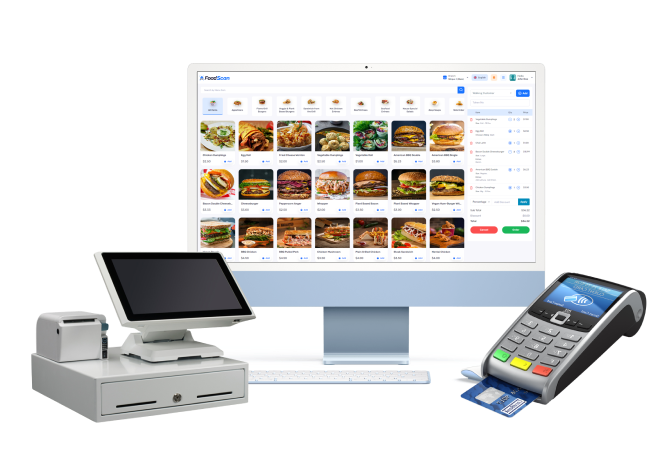What Is a Restaurant Ordering System?

A restaurant ordering system helps you take and manage orders faster, with fewer mistakes. Whether it’s your staff sending orders to the kitchen or customers ordering from their table or phone, the system keeps things smooth and organised. It saves time, reduces confusion, and helps you offer better service — all while keeping your business running efficiently.


Why It’s Essential for Today’s Restaurants
A modern restaurant ordering system isn’t just helpful — it’s becoming essential. It helps businesses handle orders more smoothly, reduce mistakes, and serve customers faster. Whether you run a dine-in restaurant, takeaway spot, or delivery service, the right system can simplify daily tasks and improve the whole experience.
With more customers expecting quick, accurate service and flexible options, restaurants need tools that can keep up. An ordering system helps you stay organized, save time, and make smarter decisions — all while keeping things running calmly in the background. It's one of the simplest ways to improve both customer satisfaction and team workflow.
Meeting Today’s Customer Expectations
People expect convenience — whether they’re dining in, picking up, or ordering from home. A good restaurant ordering system helps meet those expectations without adding stress. It allows you to take orders quickly, send them straight to the kitchen, and update customers with ease.
This kind of smooth experience builds trust and makes customers more likely to return. It also gives your team more time to focus on service, rather than chasing down paper tickets or rechecking orders.
Keeping Up with Fast-Paced Service Needs
In a busy restaurant, every second counts. Manual order taking can slow things down, especially when things get hectic. A digital ordering system helps keep the pace steady by cutting out delays and reducing back-and-forth between the kitchen and staff.
Whether it's handling peak hours or managing multiple order types at once, the right system keeps everything flowing. This means fewer mistakes, faster turnaround, and a better experience for both your team and your customers.
Key Benefits for Daily Operations
A good restaurant ordering system isn’t just about convenience — it’s about transforming how your business runs every day. From reducing pressure during busy hours to helping your staff stay organized, it brings real improvements to your workflow. These small changes add up to smoother operations, better service, and a more enjoyable experience for everyone involved. Whether you manage a fast-paced takeaway or a full-service restaurant, having the right tools in place can make a noticeable difference — not just in speed, but also in how your team communicates and works together.
It’s this behind-the-scenes efficiency that shapes the customer experience, improves morale, and helps your business grow steadily — one order at a time.
Faster Service and Happier Customers
Speed matters, especially when hungry customers are waiting. An ordering system helps you serve faster by reducing delays, sending orders directly to the kitchen, and removing the need for repeated back-and-forth. When your staff isn’t busy double-checking handwritten notes, they can focus on the actual service.
The result? Shorter wait times, fewer complaints, and a much smoother experience. And when everything flows better, it shows — customers leave more satisfied, and your team stays less stressed. That kind of positive energy can quickly turn into repeat visits and glowing reviews.
Fewer Mistakes, More Accuracy
Misheard orders, lost tickets, or unclear handwriting — these small errors can cause big issues in a restaurant. An ordering system removes that guesswork. When orders are entered once and sent straight to the kitchen, accuracy improves instantly.
That means fewer wrong dishes, fewer redos, and less food waste. It also boosts customer trust — because when people get exactly what they ordered, they’re more likely to come back. And for the team, clear communication means less tension and more confidence during even the busiest shifts.
Easier Team Workflow
Smooth service depends on good communication. When your team has a reliable system to handle orders, everyone can focus on their role without confusion. Waiters, chefs, and even delivery staff know what to do and when to do it — all from one clear source.
This helps reduce stress, especially during rush hours, and keeps the entire team in sync. Instead of shouting across the kitchen or sorting through handwritten notes, your staff can rely on a system that keeps things moving. That makes daily operations more predictable and far less chaotic.
How It Supports Different Restaurant Styles
Every restaurant runs differently — and a good ordering system should adapt to those unique needs. Whether you offer full-service dining, fast takeaway, or a mix of both, the right solution can simplify your process without forcing you to change how you work. Instead of making things more complicated, it helps bring clarity and structure to each service style. By offering tools that match your flow, it supports your team’s rhythm, your customers’ preferences, and your business goals.
This kind of flexibility means better service, more accurate orders, and a smoother experience — no matter what kind of restaurant you run.
Table Service Made Simple
For sit-down restaurants, great service starts with being present and organized. An ordering system allows staff to take orders quickly at the table and send them directly to the kitchen — no extra steps or waiting. This means fewer mistakes, faster food prep, and more time to check in with guests instead of chasing down missing tickets.
It also helps track orders and special requests with ease, making sure every table gets the right dish at the right time. When your team has this kind of support, service flows better, and your guests can truly relax and enjoy their meal from the first greeting to the final course.
Takeaway and Delivery Ready
In takeaway and delivery setups, timing and accuracy are everything. A good system makes it easy to manage incoming orders, assign them quickly, and keep everything moving — even when it’s busy. Customers can place orders online or by phone, and the system ensures nothing gets lost or delayed.
Clear order displays and automatic receipts mean less room for confusion and fewer mix-ups with customer names or instructions. It keeps your team on track and your customers happy — whether they’re picking up in person or waiting at home. With this kind of organization, you can grow your delivery business without the stress.
What to Look For in a Good System
Not every ordering system is the same — and choosing the right one can make all the difference in how smoothly your restaurant runs. A good solution doesn’t just come with features; it actually fits your business and makes everyday tasks feel easier. From the way orders are taken to how they reach the kitchen or delivery staff, everything should work in a clear, logical flow.
It’s not about fancy extras; it’s about getting the basics right so your team can focus on service and your customers get what they expect. The right system blends into your routine and quietly helps everything run better.
Easy to Use
When the system is simple, your staff can focus on what really matters — serving your guests. You shouldn’t need a manual or hours of training just to take an order or update a menu. A good ordering system is intuitive, with a clean interface and buttons where you expect them to be.
This makes it easier for new team members to learn quickly and reduces the chance of mistakes under pressure. Whether it’s placing orders, checking open tickets, or printing receipts, every task should feel natural and take just a few taps. That ease saves time and builds confidence every shift.
Reliable and Customizable
Your business isn’t like every other restaurant — and your tools shouldn’t be either. The best systems are stable, so you don’t lose orders when it gets busy, and flexible enough to match how you actually work. That might mean special modifiers for custom dishes, separate flows for takeaway orders, or different printer setups for each station.
You should be able to make adjustments without calling support every time, and updates should happen without disrupting service. A system that adapts to your setup — instead of forcing you to adapt to it — lets your team do their best work, every day.
Frequently Asked Questions
Is a restaurant ordering system hard to set up?
Not at all. Most systems are designed to get you running quickly. Setup usually involves adding your menu and connecting your devices — which the provider often helps with. Once it’s ready, staff can learn it fast, so you’ll be taking orders in no time without major interruptions to your service.
Can it work with both dine-in and delivery?
Yes. A good system supports multiple service styles, so whether guests are dining in, ordering takeaway, or requesting delivery, everything flows through one platform. You can track orders easily, manage timing, and keep things organized across the board — without switching tools or writing anything down manually.
What makes it better than pen and paper?
Speed and accuracy. With digital systems, there’s no messy handwriting, no lost tickets, and less chance of errors in the kitchen. Orders go straight from the table to where they’re needed. It’s faster, more reliable, and it helps your team work together without second-guessing anything.
Do I need internet for it to work?
Some systems do need internet, especially for cloud syncing or online orders, but many also work offline. If the internet drops, your staff can usually keep taking orders, and everything syncs up again when you’re back online. It’s built to handle real-life situations, not just perfect conditions.
How does it help with staff training?
Simple systems mean faster training. New staff can learn how to use the interface in minutes — not hours — because it’s designed to be clear and logical. That means less time explaining, fewer mistakes early on, and more confidence from day one.
Can it handle different menu types?
Absolutely. Whether your menu changes daily, includes combos, or offers custom options, most systems let you update items easily and organize things the way you need. You can group by category, add notes, or highlight specials — whatever suits your restaurant’s style.
Is it expensive to maintain?
Most modern systems are cost-effective, with monthly plans that include support and updates. You don’t need to invest in big equipment or constant fixes. Compared to lost time, missed orders, or staff confusion, a well-functioning system quickly pays for itself by making your business smoother and more efficient.
Final Thoughts: A Smarter Way to Handle Orders
Running a restaurant is already full of moving parts — your ordering system shouldn’t add to the stress. Whether you run a small café or a busy dine-in and delivery combo, having a simple, clear, and flexible way to take orders changes everything. It cuts down on mistakes, speeds things up, and helps your whole team feel more in sync.
A good ordering system doesn’t just make life easier — it makes your business better. It supports your staff, improves your service, and leaves your customers with a smoother, more satisfying experience. If you’re looking for a way to grow without the usual headaches, this might just be your next smart step.
Newsletter
Latest from Blog

Newsletter



